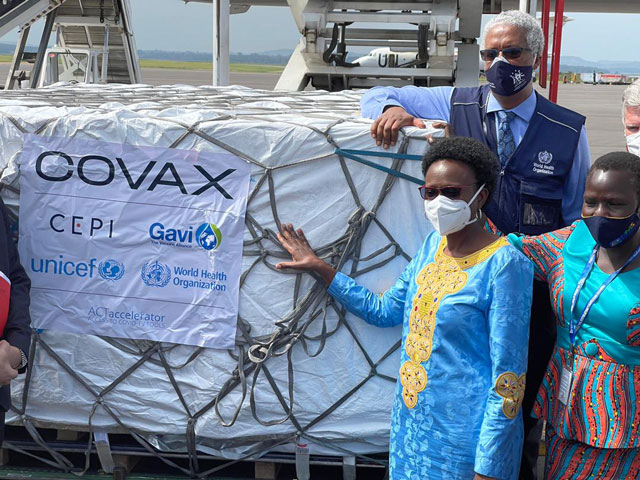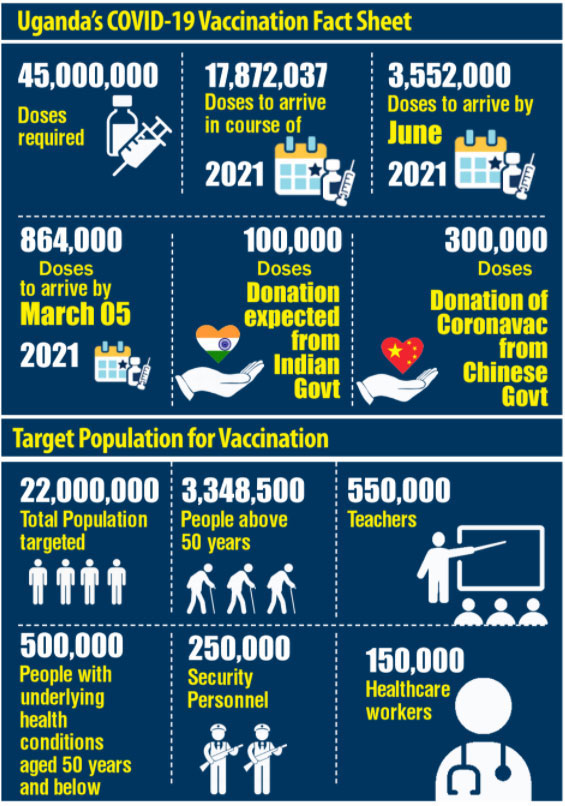
Is Dr. Jane Ruth Aceng ready for the next battle?
COVER STORY | RONALD MUSOKE | Starting March 10, millions of people in Uganda will begin taking their COVID-19 vaccine jabs in an unprecedented vaccination programme unveiled recently by Dr. Jane Ruth Aceng, Uganda’s Minister of Health.
Speaking at the ministry headquarters in Kampala on March 02, Dr. Aceng said the government intends to vaccinate 49.6% of the entire population or 21,936,011 people, in a phased manner. Each phase will cover 20% of the population which is about 4,387,202 people. The eligible population lies in the age range of 18 years and above, she said.
Aceng said the direct financial obligation for Uganda to vaccinate almost 22 million people stands at Shs582 billion (about US$ 163 million). This will go into buying the vaccines, handling storage and distribution and related operational costs for deploying vaccines.
Aceng said Uganda is receiving the vaccines because it has fulfilled its obligations to get the AstraZeneca vaccines under the COVAX Facility from the Serum Institute of India among which include; having a national vaccine deployment plan, an indemnification agreement with the Serum Institute, a vaccines purchase agreement cleared by the Solicitor General and all regulatory approvals from the National Drug Authority (NDA).
“Uganda is therefore ready to receive vaccines,” she said, adding that her ministry will also issue a statutory instrument as is required by the Public Health Act and the Immunization Act 2016 for emerging and re-emerging epidemics to guide the vaccination process.
Among the first priority of people to be inoculated are about 150,000 health workers (both public and private sector); 250,000 security personnel (UPDF, Police and Prisons) and about 550,000 teachers.

Others include people with underlying health conditions aged above 50 years (500,000) and other emerging high risk and priority essential groups such as employees in airlines and media, prisoners, tour operators and guides, bankers, immigration officers, Uganda Wildlife Authority (UWA), Uganda Revenue Authority (URA) and humanitarian workers.
The third category includes people aged 18-50 years but with underlying health conditions like hypertension, diabetes, cancer, organ diseases such as liver, kidney or heart disease. Aceng said each category will be alerted on the days on which to report for vaccination. But this will also be a phased activity depending on the availability of vaccine doses.
All eligible people will be required to provide a National Identification Card or a passport for non-Ugandans and go to one of the government health centre IIIs, IVs, district hospitals, regional referral, national referral hospitals and specialized institutions which have been designated as vaccination service points in every district and city. The vaccines will be given 56 days (8 weeks) apart and after taking the first jab, one will receive a vaccination card and will be required to present this card for the second dose.
Health workers in the public health facilities will receive vaccines from their work places while those from the private-not-profit and private facilities will be required to go to the nearest public facility for their vaccines.
Next in line are teachers who are returning to school after almost a year of redundancy. These too will be required to access vaccines from the nearest public health facility starting from health centre III up to national referral hospital level.
Meanwhile, Aceng said, estimation of the quantities of vaccines required for the security forces (UPDF, Police and Prisons) is ongoing. She said this exercise will be handled within their facilities under the guidance of their health workers.
In the second and third phases, the ministry intends to roll-out the vaccination programme to the 18-50 year age-group in a staggered manner until 49.6% of the Ugandan population is vaccinated. Aceng said the exercise will also be guided by the local epidemiology (incidence and spread) of the disease.
Ahead of the vaccination exercise, the Health Ministry has been consulting with the National Identification and Registration Authority (NIRA), the Uganda Bureau of Statistics (UBOS) and the Ministry of Public Service to develop an electronic information system for registration and capturing of vaccination information to completion of second dose; including analysis and SMS reminders on drop-outs from the vaccination programmes.
“This system will enable accountability for vaccines on a daily basis,” the minister said.
Speaking about the sensitization and awareness creation, Aceng said, ministry, district health teams and district COVID-19 task forces had started engaging with all stakeholders to create awareness and demand.
The batch was received by @JaneRuth_Aceng @tegegny @USAmbUganda @EUinUG and other dignitaries. pic.twitter.com/abB8uARBta
— WHO Uganda (@WHOUganda) March 5, 2021
She said besides encouraging district leaders to use local government structures of LCs and village health teams to mobilise and sensitize communities about the vaccines and procedures to be followed for one to be vaccinated, her ministry had, starting March 02, run a campaign targeting the public with the purpose of creating awareness about the vaccines that are to be used in Uganda.
The mass media campaign is meant to give the population clear information on vaccines given the misinformation circulating. The campaign will run on 40 radio stations and five televisions in the country and the message will be delivered both in English and in local dialects.
“At the community level, information packs for health workers and village health teams have been prepared, and dissemination commences with immediate effect. We hope that at that level, community members will be reached with all the required information regarding the vaccines deployment,” she said.
“We encourage members of the public to only share information provided by the ministry and when in doubt, to always clarify with the ministry or your local district health officers.” (CLICK TO GO TO PAGE 2)
 The Independent Uganda: You get the Truth we Pay the Price
The Independent Uganda: You get the Truth we Pay the Price




